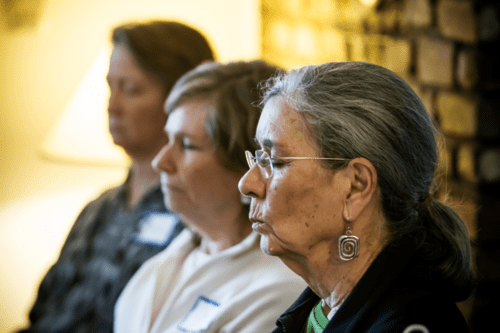What is Acceptance and Integration Training®?
Acceptance and Integration Training (AAIT) is an approach to alleviating psychological pain while contributing to spiritual wellbeing. It is a non-narrative, a-historic model designed to efficiently resolve clients’ presenting problems while supporting them in the cultivation of inner steadiness.
AAIT™ emanates from a convergence of the philosophical tradition of non-dualism and streams of bio-psychosocial theories that have informed psychotherapeutic practice from a number of traditions and are familiar to most therapists.
WHAT DO YOU MEAN BY NON-DUALISM?
 Non-dualism holds that all apparent dualities are two sides of an inseparable whole. It is the philosophical background of interconnectedness that informs the underlying assumption from which the key therapeutic processes operate to facilitate integration, recreating the experience of unity. It is the idea of not two but one.
Non-dualism holds that all apparent dualities are two sides of an inseparable whole. It is the philosophical background of interconnectedness that informs the underlying assumption from which the key therapeutic processes operate to facilitate integration, recreating the experience of unity. It is the idea of not two but one.
We live in a bi-polar universe, day night, man woman, winter, summer. We have the same dynamic happening psychologically, anger / peace, joy / sorrow, fear / security. When we integrate these seeming opposite states, the tension of being pulled between them disappears and we feel an inner freedom. Imagine choices made free from reactivity.
The focus with AAIT™ is not on increasing insight about the influences of our childhoods, though that often happens naturally. Nor is it about struggling to make the mind behave, again, this is a natural by-product of the work. The focus is on acceptance and integration of opposites.
This is an entirely different therapeutic paradigm.
COULD YOU SAY MORE ABOUT THOSE DIFFERENCES?
 Other models often involve a good bit of story telling, trying to find the solution in the story. Or, there is quite a lot of efforting on the client’s part to make changes and get relief often through developing mindfulness skills or changing cognitive habits. Though valuable, it can take a long time for our clients to access real relief and to consistently feel better.
Other models often involve a good bit of story telling, trying to find the solution in the story. Or, there is quite a lot of efforting on the client’s part to make changes and get relief often through developing mindfulness skills or changing cognitive habits. Though valuable, it can take a long time for our clients to access real relief and to consistently feel better.
With AAIT™, we lean into the understanding that integrating two opposing states alleviates the charge of both states, creating an inner freedom from the originating pain. This freedom tends to last and opens up new options for the client who is now liberated from automatic reactivity that was previously triggered by the problem.
Also, AAIT™ is an overtly collaborative model. Clients are actively involved in establishing their session goals and they engage in embodiment practice. Surprisingly, embodiment practice compliance tends to be fairly high with this approach as clients feel such immediate results.
WHAT KINDS OF ISSUES DO CLIENTS WORK ON USING AAIT™?
Anxiety, self esteem, depression, relationship issues, trauma, shadow integration, work problems, substance abuse, etc. Also, the model is being used with great success helping children and adolescents.
WHAT KINDS OF THERAPISTS TEND TO THRIVE USING AAIT™?
Therapists who find pleasure in helping their clients feel better quickly and enjoy a collaborative relationship with their clients. Therapists who enjoy working in the confluence of psychotherapy and spirituality are particularly drawn to this work.



HOW CAN WORKING ON A PROBLEM IN PSYCHOTHERAPY CONTRIBUTE TO SPIRITUAL WELLBEING?
I once asked a client how her psychotherapeutic work had influenced her spiritual wellbeing. She responded, “If I’m triggered, I’m not present.” She went on to talk about how easily accessible the fullness of the present is available to her. Other clients point to an increase in commonly held spiritual values such as compassion, awareness, present focused attention, non-attachment and acceptance. They begin feeling more at ease with themselves and others, citing an increasing feeling of wholeness.
HOW DID AAIT™ COME INTO BEING?
I had the great good fortune early in my career to be taken under the wing of another therapist, Jae Brainard, L.C.S.W. Jae was my first mentor. Because of Jae, I sought out mentoring throughout my career. AAIT™ is the confluence of my years of study, practice, and training with master therapists, primarily, Dick Olney and Zivorad Slavinski.This model is also influenced by my study with Bob and Mary Goulding (the founders of Redecision Therapy). I was fortunate to have been mentored by these masters and am now fortunate to share the convergence of this wisdom with others. At this point, I am one of two therapists in the US authorized to train trainers in Slavinski’s work.
HOW IS AAIT DIFFERENT FROM SPIRITUAL TECHNOLOGY AND SELF ACCEPTANCE TRAINING?
The primary differences lie in the phases of a typical AAIT™ session. Beginning with directing clients’ awareness to the effect of the work they did in the previous session illumines the result of that work. Such reflection, though momentary begins empowering clients to take hold of their mental well-being. Another difference is the overt collaboration with the client, again empowering them to assume responsibility for themselves. A significant difference is the strategic use of embodiment practice. AAIT™ practitioners learn to help clients develop active embodiment practices that help them to become established in steadier states of being. We encourage our clients to engage in caring for their mental health, just as they would with their dental health. Most of us would not go to sleep without brushing our teeth, but we allow layers of tension to accumulate without a second thought. With AAIT™, we support our clients in learning to address their problems as they arise, regularly attending to their inner state.
WHAT ARE THE TRAINING REQUIREMENTS TO GET STARTED LEARNING AAIT™?
Join us for an AAIT™ Foundations course. It’s a great way to get started. If you prefer, contact me about sponsoring a live training in your community.
COULD I EXPERIENCE AAIT™ BEFORE COMMITTING TO TRAINING?
Absolutely, you are welcome to contact me for an individual appointment.
HOW CAN I JUSTIFY THE EXPENSE FOR MORE TRAINING WHEN I GO TO A YEARLY WORKSHOP TO KEEP UP WITH MY CEU REQUIREMENTS?
This training is very experiential and practical. You will not be sitting in a room taking notes for two days. You will be observing and practicing procedures while learning more about how to lean into the principles and phases that support this work. The bonus consultation groups insure that you understand how to implement what you have learned and address any snags you may encounter along the way.
I guarantee the usefulness of what you will learn. I stand behind this work and the trainings I offer 100%. If after fully participating in training with me, you decide what you have learned is not of value to you or your clients, I will return your investment with a heartfelt smile. I know the value of this work and do not want to keep the money of someone who does not find it to be valuable.
Beyond that, most professional organizations have means of gathering CEUs other than through traditional outlets. For instance, reading, supervision and trainings such as this often qualify as continuing education hours, even if not pre-approved by your profession’s governing organization. That said, of course, check with your professional organization and you will likely find CEU guidelines for which this training would qualify.
For instance with social work, I know this training would qualify for CEU hours.
HOW DO YOU INTRODUCE AAIT™ TO CLIENTS?
As AAIT™ is a paradigm shift for most clients seeking therapy or coaching, practitioners typically take some time to educate clients about the model and how we can best collaborate on their care. We do this in conversation as ‘teachable moments’ arise and we will share introductory handouts in their welcome packet. At the heart of how we introduce this model is the intention to set the state for collaboration. Take a look at this introduction to AAIT as an example.
COULD I CONTACT OTHER THERAPISTS YOU HAVE TRAINED?
Of course, just get in touch with me at info@aait.solutions.
DO YOU WORK PRIVATELY WITH OTHER PROFESSIONALS?
I do. In fact, much of my practice at this point comprises psychotherapists, psychiatrists clergy and coaches. You are welcome to contact me to see if time together might serve you.
I STILL HAVE A FEW QUESTIONS, CAN I CONTACT YOU?
Of course, email me at info@aait.solutions.

